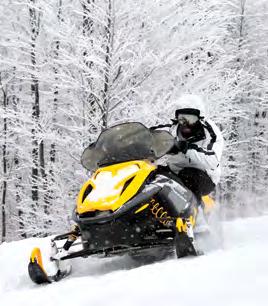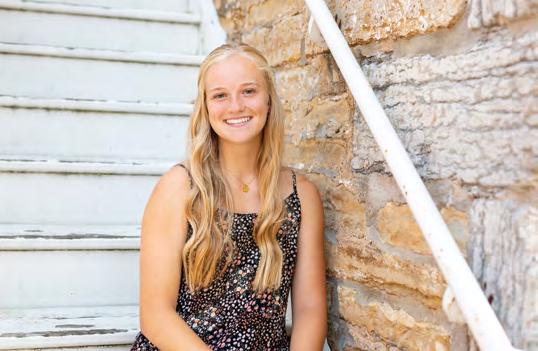
5 minute read
Youth News
Brenna Solheid MnUSA Scholarship Recipient
In the September issue the 2021 MnUSA scholarship recipients were announced. This issue we are featuring an essay from Brenna Solheid. The MnUSA Scholarship Program will continue in 2022. Details will be announced in November with applications due by February 28, 2022.
Advertisement
MnUSA Scholarship recipients are selected by a committee on the basis of their essay, academic achievement, leadership, participation in school, snowmobile and community activities, work experience, and additional insight from two outside references.
Brenna Solheid graduated from New Prague High School in New Prague in May 2021 and plans to study engineering at North Dakota State University. She is an active member of the New Prague Snowdrifters and helps with ditch cleanup, fundraisers and their vintage snowmobile event. Her high school activities include tennis and gymnastics (also team captain in both), Green Team, Spanish Club, Choir (also choir president) and academics. In addition to National Honor Society, she was Academic All State four years, A Honor Roll, Language Department Student of the Month and received awards for Outstanding Coral Participation and Solo Ensemble. Brenna is the daughter of Dan and Kris Solheid and is the recipient of a $500 scholarship.
With the many restrictions put on Minnesota residents due to the COVID pandemic, people are embracing outdoor activities, and many have been introduced to or returned to snowmobiling. With all the activity comes a greater responsibility for all riders to respect the generosity of landowners and stay on the trail.
ISABELLA, MINNESOTA
N47° 38.813 W091° 27.250
WELCOME
ATV’S MOTORCYCLES SLEDS HUNTERS FISHERMEN
• Modern Cabins • Gas/Oil • On/Off Sale • BWCA/Canoe Outfitting
9702 Hwy. 1 Isabella, MN (218) 323-7681 www.knottedpine.com
We’re right at the intersection of Tomahawk and Yukon Trails
Brenna – What would you do to educate and stop riders of all ages and experience levels from trespassing and to say on the trails?




According to Minnesota DNR, there are over 22,000 miles of groomed snowmobile trails throughout Minnesota; however, every year trails have to close or are lost entirely due to trespassing and disregard for the trails. The once reliable routes friends and families take every year are now in danger of being lost because of the acts of new and experience riders. Although it can be tempting to ride off into fresh powder instead of staying on the trail, by following the rules, everyone can continue to enjoy all Minnesota’s winters to offer.
One way I would work to keep riders on the trails is implementing more recognition of the problem in the snowmobile safety training course. The class provides valuable knowledge regarding snowmobiles, hand signs, and trail signs, but it does touch onto why staying on the trails is vital to keeping them open. I remember taking the class and feeling very confident about my abilities to ride on a trail with others; however, I lacked knowledge regarding the importance
of following the trail rules. With a quick and simple change, more new riders will follow the trails and hede by the rules. An extra video or even a guest speaker will be enough of a push to implement the idea into the brains of the youth. These children will then grow up and show good trail etiquette to their children who will gain knowledge from the class and from their parents.
Although implementing more information into the younger kids’ courses is beneficial, there must also be an increased focus on the more experienced riders who are usually adults or older teenagers. These more experienced drivers are going to feel more comfortable riding off the trail; therefore, they are likely to trespass more. Educating adults is difficult, but there could be new requirements for snowmobile riders. These could include mandatory updates to the permit every few years. The permits would only be renewed if the rider watched a short video describing the problems riding off trails causes, and would require a written agreement to abide by the rules. Yes, it might not cause large change; however, it would force people to be reminded of their role in keeping the trails open. This update could even be every 5-10 years, and it would not need to cost extra money. The more experienced riders would be reminded of the importance of trails regularly and can pass this on to others.
Furthermore, the snowmobiling clubs across Minnesota could provide more opportunities for the people volunteering their land for trails to speak out against any problems they have. In New Prague, there is a summer picnic to thank them, but it is not a moment to mention complaints or ideas to maintain stricter adherence to the trail rules. The people dedicating their land are the people who can easily take it away. Their opinions are valuable in deciding the future of educating riders. With another meeting during the winter, when snowmobiling occurs, problems can be discussed and addressed quickly. This can create change before those who allow their land to be used for trails want to pull out of the trail system. An easy addition, like another meeting with landowners, will provide rapid small changes to occur more often overall keeping the trails open and safe.
Finally, the signs along the trails are small and can often be hard to see depending on weather and speed. By either increasing the size of the signs or implementing another change to the signs, riders will be able to see the trails clearer making it easier to stay on them. Oftentimes, experienced riders are going at fast speeds causing the small signs to speed past their view. By having better identification of the trails, people of all experience will be more likely to abide by them.
The issue of trespassing cannot be easily fixed with one method; however, by combining many small actions, trespassing can decrease greatly. Riders of all experience will probably ride off the trails at some point, but with increased knowledge regarding the problem and more cooperation with landowners change can occur for the better.










